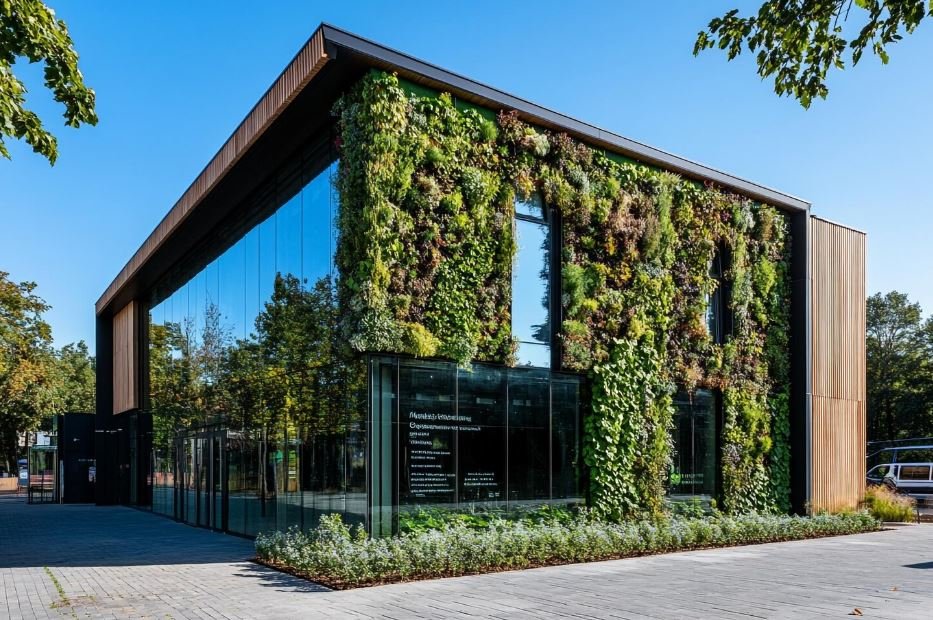
Observing a swarm of bees carefully reorganize a garden, each movement creating a more balanced ecosystem, is remarkably similar to the spread of green facades. Architects are coming to understand that vegetated skins, living walls, and climbing plants are not merely ornamental elements but rather highly functional building elements that are changing the way cities function and breathe. Because it subtly rewires construction practices that previously depended almost exclusively on concrete, glass, and insulation boards, the change feels especially novel. In response to climate change, foliage is now acting as a structural assistant, cooling surfaces, filtering toxins, and creating an insulating blanket.
Urban planners’ discussions have become very clear in recent days: the competition for sustainable architecture is not merely theoretical. As incredibly effective design collaborators, plants are taking the place of passive surfaces with dynamic textures that react organically to light, moisture, and heat. The reasoning for this change is surprisingly straightforward: buildings covered in greenery behave differently than those with traditional cladding, absorbing heat more slowly, evaporating moisture more steadily, and using less energy much more quickly.
| Key Element | Details |
|---|---|
| Core Concept | Plants used as structural, thermal, and ecological building components |
| Main Benefits | Cooling, insulation, biodiversity, air purification, noise reduction |
| Architectural Relevance | Vertical gardens, green facades, living walls, bio-materials |
| Urban Impact | Lower heat islands, fewer emissions, notably improved air quality |
| Environmental Role | Reduced energy use, faster cooling cycles, carbon absorption |
| Popular Systems | Green facades, modular living walls, retaining living walls |
| Celebrity Influence | Designers inspired by Leonardo DiCaprio, Björk, Zaha Hadid estates |
| Industry Trend | Rapid adoption in dense cities seeking greener architectural identity |
| Major Inspiration | CaixaForum Madrid, Bosco Verticale, Urban Forest Brisbane |
| Reference Link | https://www.greenroofs.org |
Using information from environmental studies, architects found that structures with green facades provide stable indoor temperatures with little mechanical interference because they lose heat much more slowly at night. In cities that are experiencing rising temperatures, where the heat island effect exacerbates discomfort and raises energy demand, this approach has proven especially helpful. Structures imitate natural ecosystems through meticulously planned foliage systems, generating cooler air pockets that float through streets like soft reminders of vanished forests.
Thanks to developments in modular systems that enable plants to climb, cling, or cascade across vertical surfaces, the popularity of green walls has increased dramatically over the past ten years. In the past, intricate irrigation systems were needed for living walls, but thanks to technological advancements, plants can now flourish with drip systems that use very little water. This has been embraced by architects as a wonderfully flexible approach that combines ecological engineering with artistic aspirations. This was first shown by CaixaForum Madrid, which transformed a blank wall into a lush tapestry that immediately changed the area around it.
Celebrity architects and environmentally conscious public leaders who enthusiastically embrace the message are echoing the shift. By making investments in regenerative architecture, Leonardo DiCaprio supports the notion that buildings can be both aesthetically pleasing and responsibly constructed. Buildings are not interruptions but rather extensions of natural landscapes, according to environmental designers with whom Björk works. Even properties with ties to Zaha Hadid’s legacy experiment with organic façades, incorporating greenery into curved geometries in unexpected and motivating ways. Their combined impact gently encourages the sector to use natural materials, reaffirming the idea that sustainability can be both stylish and expressive.
Cities are discovering that plants offer more than just shade or aesthetic appeal thanks to strategic collaborations between engineering companies and botanical researchers. By absorbing nitrogen dioxide, capturing particulate matter, and transforming trapped pollutants into innocuous compounds that are stored in soil, they function as active filters. Vegetated structures can lower ambient temperatures by several degrees, according to environmental data collected over the past ten years. Some studies have even reported energy savings of up to 30% during the hottest cooling seasons. Municipalities are now encouraged to incorporate green facades into their climate adaptation plans as a result of these findings, which have significantly altered design logic.
The difficulty for medium-sized companies retrofitting old buildings is frequently striking a balance between sustainability objectives and budgets. Green facades provide surprisingly cost-effective solutions that lower long-term operating costs, effectively addressing that tension. Climbing ivy and honeysuckle quickly provide shade in an old warehouse, preventing heat intrusion and lowering cooling costs. Workers describe the acoustic conditions in a busy commercial building wrapped in modular living walls as significantly better than those in structures with a lot of concrete.
Architects have drawn attention to the expanding relationship between mental health and biophilic design. People who live close to green facades report feeling more connected to their surroundings, having calmer moods, and complaining less about the heat. Greenery softens harsh architectural lines and transforms rigid geometry into soft, pulsating surfaces when it spills across balconies or climbs stairwells. Because it alters people’s perceptions of built environments and serves as a reminder that structures can coexist peacefully with organic life rather than displacing it, this transformative effect is especially novel.
Another benefit of incorporating plants directly into construction was that retaining living walls stabilize soil, reinforce slopes, and significantly lessen erosion. These systems create embankments that resemble sculpted landscapes rather than engineered barriers by fusing the beauty of vegetation with structural strength. Funding is still the largest obstacle for early-stage sustainability projects, but retaining walls provide strong proof that environmental design can be both practical and beautiful.
Fast-growing natural resources like bamboo, hemp, and flax have become popular among architects since the introduction of new climate policies that encourage the use of greener materials. These natural materials lessen the need for carbon-intensive building techniques, which enhances green facades. In Nordic and Japanese-inspired designs, where natural textures and simplicity create calm, airy living areas, the trend is especially inventive.
Businesses are experimenting with bio-based panels and vegetation skins through strategic partnerships with environmental institutes, combining two sustainable strategies into a single, cohesive façade. This method has shown great success in controlling interior temperatures, simplifying large-scale building operations, and freeing up energy funds for other environmentally friendly projects.
It is anticipated that plant-based architecture will transform construction psychology in the years to come. What used to appear to be ornamental climbing vines is now understood to be a very resilient protective layer that, in some climates, can outlast synthetic materials. As more buildings embrace this soft armor of greenery, urban areas may transition to more peaceful, cooler, and breathable environments.
Expectations are changing and a new standard for architecture is being established by the green façade revolution. It makes it abundantly evident that how well we let nature blend in with the areas we live in will likely define construction in the future rather than the amount of concrete or steel used.
